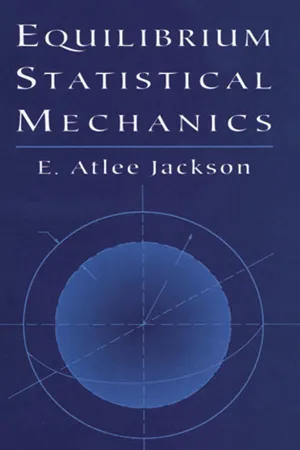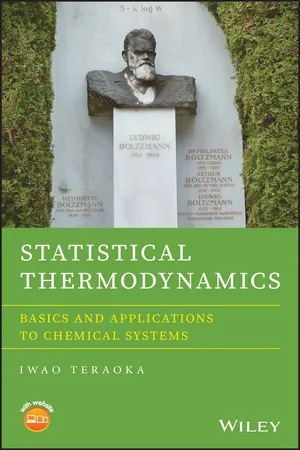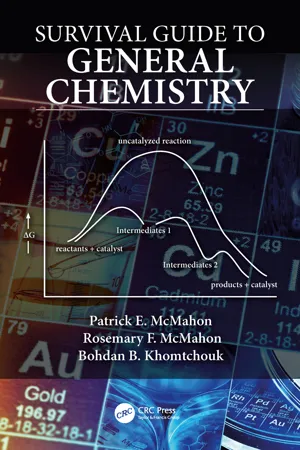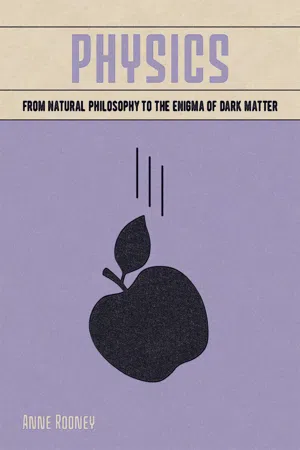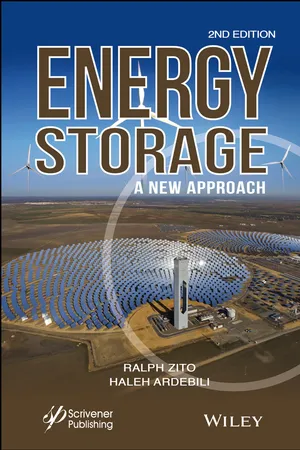Physics
Interaction Energy
Interaction energy refers to the potential energy associated with the interaction between two or more objects or particles. It arises from fundamental forces such as gravitational, electromagnetic, or nuclear forces. The amount of interaction energy depends on the relative positions and properties of the interacting objects or particles.
Written by Perlego with AI-assistance
Related key terms
Related key terms
1 of 4
Related key terms
1 of 3
7 Key excerpts on "Interaction Energy"
- eBook - ePub
- E. Atlee Jackson(Author)
- 2012(Publication Date)
- Dover Publications(Publisher)
Some of these limitations due to quantum-mechanical effects will be taken up in Section 5. Before considering the interaction between particles, we should first define the kinetic and potential energy of a collection of noninteracting particles (they do not exist, of course, but it is often useful to consider such a model). If a system contains N particles, the total kinetic energy is defined simply as the sum of the individual kinetic energies of the particles: (16) where m i, v i) is the mass and velocity of particle i. Moreover, if these particles are in an external (conservative) force field, such as an electric field or gravity, then the total potential energy due to these forces is again the sum of their individual potential energies: (17) Note that, just as E kin depends on the value of each velocity v i, φ ext depends on the position of each particle r i. Now we turn to the question of the interactions between particles and between molecules. Just as we can describe conservative external forces in terms of a potential energy Φ (r i), we can frequently represent the intermolecular forces by a potential energy Φ(r ij). In this case r ij = r i − r j = [(x i − x j) 2 + (y i − y i) 2 + (z i − z i) 2 ] 1/2 is the distance between the molecules, and the force on particle i (due to particle j) is given by If the potential depends only on the magnitude of the separation between the molecules, then (18) and the force is along their connecting line, as illustrated in Figure 4. Note that F i = − F j, so the forces are equal but in opposite directions. Figure 4. Intermolecular forces The intermolecular forces can be conveniently divided into repulsive forces and attractive forces. These repulsive forces may originate in electrical forces, nuclear forces, or certain quantum-mechanical effects. For example, when two neutral atoms come very close together, the electrons around each atom begin to overlap - eBook - ePub
Statistical Thermodynamics
Basics and Applications to Chemical Systems
- Iwao Teraoka(Author)
- 2019(Publication Date)
- Wiley(Publisher)
3 Energy and InteractionsFor a given chemical system, applying the statistical mechanics starts with writing a function called the partition function. The writing requires that we know the energy of each molecule in the system. We learn in this chapter how to describe and specify the energy of each molecule.In the absence of an applied external field and in the absence of interaction between molecules, the energy of a molecule consists of the energy due to the movement of the molecule as a whole and the energy for the movement of atoms within the molecule. We first use classical mechanics to describe the movements and the kinetic energy. Toward the end of the chapter, we learn quantum‐mechanical methods to describe the kinetic energy. “Classical” means that the movement of a molecule follows Newton's equation of motion. It does not only describe the center‐of‐mass translation but also the rotation and the vibration.In Sections 3.1 and 3.2 , we first consider kinetic energy of atoms and ions and kinetic energy of diatomic molecules, respectively, that do not interact with each other. In Section 3.3 , we look at the energy of polyatomic molecules. Then, in Section 3.4 , we learn different types of interaction between molecules. In these four sections, we rely on classical mechanics. After examining briefly an extensive nature of the interaction in Section 3.5 , we turn to quantum mechanics to describe all the components of the energy in Section 3.6 .3.1 Kinetic Energy and Potential Energy of Atoms and Ions
3.1.1 Kinetic Energy
Consider an atom i isolated from the other atoms. There is no field applied. The energy of the atom consists of the kinetic energy εi,kin= ½mivi2 and the energy of the electron εi,elec:3.1where miis the mass of the atom that moves at velocity vi. Electrons are not excited to higher energy levels unless the temperature is as high as the one on the surface of the sun. We examine this situation in Section 3.6.4 . In practice, εi,elecis a constant, and therefore we do not consider εi,elecin this book, unless otherwise mentioned. The atom is isotropic (no specific orientation), and therefore there is no rotation. Equation (3.1 - eBook - ePub
- Patrick E. McMahon, Rosemary McMahon, Bohdan Khomtchouk(Authors)
- 2019(Publication Date)
- CRC Press(Publisher)
18 Concepts of Potential Energy, Enthalpy, and Bond Energy CalculationsI CONCEPT OF ENERGY Energy is the capacity to do work and/or to produce heat. It can be conveniently divided into potential energy and kinetic energy.Potential energy (PE) can be defined as energy stored based on the position or arrangement of matter. Potential energy can be released, for example as kinetic energy, in response to a force.Kinetic energy (abbreviated as kE) is the energy of motion of matter. Kinetic energy includes both the motion of bulk matter and the production of heat. Heat is thermal energy and is a measure of the kinetic energy of motion of individual atoms, molecules, or ions in bulk matter.Kinetic energy (kE) of matter is proportional to mass and the velocity: kE = ½mv2The metric units of the equation are (kg) × (m/sec)2 = (kg-m2 /sec2 ) = one JouleJoule (J) is the metric unit of energy; one kiloJoule (kJ) = 1000 J; 4.184 Joules = 1 calorie.Temperature (in °K) is a measure of the average kinetic energy of atoms and molecules.The law of conservation of energy (a form of the first law of thermodynamics) states that energy can neither be created or destroyed during any process in the universe: total energy of the universe is constant. Forms of energy are interconvertible; one relationship is the interconversion of kinetic and potential energy.An object at a height converts gravitational potential energy to kinetic energy of motion (bulk motion and heat) when it falls. Conversely kinetic energy can be converted back to potential energy if work is performed to lift the object back to its original height.Chemical potential energy stored in the electromagnetic force of chemical bonds can be converted to kinetic energy during a chemical reaction. For example, an explosion converts chemical bond potential energy to work, heat, (and light). Conversely, kinetic energy can be converted to chemical potential energy when it is consumed to form certain types of chemical bonds. - eBook - ePub
The Really Useful Science Book
A Framework of Knowledge for Primary Teachers
- Steve Farrow, Amy Strachan(Authors)
- 2017(Publication Date)
- Routledge(Publisher)
The ultimate source of energy in the universe is that which exists in the bonding between the particles in the atom, and in the bonds between the atoms and molecules of all matter. All of the known sources and forms of energy can eventually be traced back to the attraction and repulsion of atomic and molecular particles. These forces of attraction and repulsion are thought to be of four basic kinds: strong nuclear, weak nuclear, electromagnetic and gravitational forces.A fundamental principle of science that relates to energy is the law of conservation of energy. Basically, this states that energy can be converted from one form to another, but cannot be created or destroyed. What is believed to happen is that energy is not ‘used up’ by a system, but is transferred or converted into other forms of energy. So, the energy released by the combustion of petrol fuel in a car is converted into heat, sound, mechanical movement, electricity (which is then used as a further energy supply) and so on. None of the original energy derived from the breaking of the hydrocarbon bonds in the fuel is ‘lost’, but it can all be accounted for, at least theoretically, in terms of energy transfer or conversion.TEACHING IDEA
Using a money analogy, we can explain that energy does not simply disappear. Energy is moved from one place to another, in the same way that our money is moved from our savings to a supermarket cash register. Like energy, money can be saved until we want to use it!Modern versions of this principle would extend the law to include mass as well as energy. Albert Einstein, with the famous equation e = mc2 , showed that mass and energy were theoretically interconvertible (e = energy; m = mass; c = the speed of light, a constant).It is now known that, when matter releases its energy, a small loss of mass results. In normal chemical reactions, the rate of conversion of mass to energy is so small that it is difficult to measure accurately. In nuclear reactions, however, so much energy is released that the change in mass is large enough to be measurable. - eBook - ePub
Physics
From Natural Philosophy to the Enigma of Dark Matter
- Anne Rooney(Author)
- 2020(Publication Date)
- Arcturus(Publisher)
CHAPTER 4Energy fields and forces
When a force acts to move a mass it seems obvious to us that energy is involved. So it may seem surprising that for all the consideration of forces since antiquity, energy was largely neglected by the early natural philosophers. The concept of energy is relatively new, emerging only in the 17th century. Indeed, the term ‘energy’ (from the Greek energia , coined by Aristotle) was only introduced with its modern meaning in 1807 by the genius and polymath Thomas Young (of the double-slit experiment). The most obvious forms of energy are light and heat, both of which come for free from the Sun. Humankind has also harnessed chemical energy (released by burning fuels), the gravitational energy of a falling body, the kinetic energy of wind and moving water, and, latterly, electric and nuclear energy.The conservation of energy
Just as matter is conserved, being neither created nor destroyed, so energy too is conserved. It may be converted from one form to another – and this is how we harness energy to do useful work – but that energy is never actually spent. Galileo noticed that a pendulum converts gravitational potential energy into kinetic energy or the energy of movement. When the pendulum bob is at the high point of its swing it is momentarily still, and has maximum potential energy. This is converted into kinetic energy as the bob moves, and the bob regains potential energy as it climbs up on the other side of its swing.‘There is a fact, or if you wish, a law, governing all natural phenomena that are known to date. There is no known exception to this law – it is exact so far as we know. The law is called the conservation of energy.It states that there is a certain quantity, which we call energy, that does not change in manifold changes which nature undergoes. That is a most abstract idea, because it is a mathematical principle; it says that there is a numerical quantity which does not change when something happens. It is not a description of a mechanism, or anything concrete; it is just a strange fact that we can calculate some number and when we finish watching nature go through her tricks and calculate the number again, it is the same.’ - eBook - ePub
Energy Storage
A New Approach
- Ralph Zito, Haleh Ardebili(Authors)
- 2019(Publication Date)
- Wiley-Scrivener(Publisher)
The history of the development of physical concepts is not the prime concern here, but some knowledge of their evolution does serve to bring more closely to our attention and scrutiny a better appreciation of terms that we employ daily. Sometimes it is necessary to begin understanding or developing a body of knowledge in order to make certain basic assumptions on an entirely intuitive basis. As scientifically unsatisfying as that may be, it is unavoidable at times. One could draw a weak comparison to plane geometry (Euclid) with regard to its various axioms and the declaration that parallel lines never meet. Even the concept of straight lines is rather intuitive in nature.Perhaps the best definition is that a force is required to change the motion of a body. Many problems arise in finding acceptable definitions for the basic parameters of physical science, namely, the abstract concepts of mass, time, force, and energy. However, we must learn to be satisfied with definitions that leave something to be desired in order to move on toward generating a working body of mechanics that enables us to design and build practical devices that serve our purposes.An interesting definition of energy comes from the Grolier Encyclopedia, which states:Energy can be measured in terms of mechanical work, but because not all forms of energy can be converted into useful work, it is more precise to say that the energy of a system changes by an amount equal to the net work done on the system … In classical physics, energy, like work, is considered a scalar quantity; the units of energy are the same as those of work. These units may be ergs, joules, watt-hours, foot-pounds, or foot-poundals, depending on the system of units being used. In modern science, energy and the three components of linear momentum are thought of as different aspects of a single four-dimensional vector quantity, much as time is considered to be one aspect of the four-dimensional space-time continuum … Energy exists in many different forms. The form that bodies in motion possess is called kinetic energy. Energy may be stored in the form of potential energy, as it is in a compressed spring. Chemical systems possess internal energy, which can be converted by various devices into useful work; for example, a fuel such as gasoline can be burned in an engine to propel a vehicle. Heat energy may be absorbed or released when the internal energy of a system changes while work is done on or by the system. (1993) - eBook - ePub
Foundations for Teaching Chemistry
Chemical Knowledge for Teaching
- Keith S. Taber(Author)
- 2019(Publication Date)
- Routledge(Publisher)
10 Energy in chemistry and chemical bondingThis chapter discusses one of the key topics in the chemistry curriculum, chemical bonding. This is a highly abstract concept area where a range of models and simplifications are taught. It is also an area where students commonly develop tenacious alternative conceptions (Taber, 2013a), and thus where the teaching approach can be very important in channelling student thinking towards scientific models. One particular feature of many students’ thinking is that they learn about chemistry topics such as bonding with no cognisance of the basic physical principles they have been taught elsewhere in science. Yet if students are to develop scientific understandings of chemistry, they need to appreciate where key concepts from physics, such as force and energy, are applied. This chapter reflects this imperative by first considering the role of the energy concept in understanding school chemistry before specifically addressing chemical bonding concepts.Appreciating the physicists’ concept of energy and how this applies in chemistryEnergy is one of the most fundamental and ubiquitous concepts in science. It is also one of the most abstract. It is closely associated with another abstract concept – force. The primary responsibility for teaching these ideas falls upon the physics teacher. There are, however, consequences here for the teacher of chemistry:- To avoid the potential of confusing students, the science department as a whole should have a common way of talking about energy and force so the ideas are used consistently across different topics and science subjects.
- As energy is an important concept in chemistry, the teacher of chemistry has to rely on what has been taught and how it has been taught in another subject.
- The teacher of chemistry not only relies on what has been taught in physics but on whether students can transfer their learning in physics to other subjects.
The latter consideration is not insignificant. The question of transfer of learning, applying what has been learnt beyond the original context, is seen as a major issue in education (Lobato, 2006) because students often struggle to apply what they have learned in one context in other relevant situations. This is an example of a ‘fragmentation’ learning impediment (see Figure 3.1 ), as the learner does not make intended links with prior learning (see Figure 10.1
Index pages curate the most relevant extracts from our library of academic textbooks. They’ve been created using an in-house natural language model (NLM), each adding context and meaning to key research topics.
Explore more topic indexes
Explore more topic indexes
1 of 6
Explore more topic indexes
1 of 4
